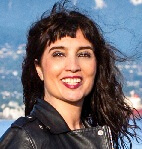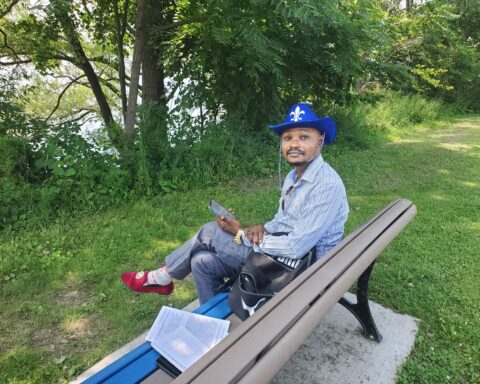When a last minute e-mail alerted me to a change in curtain time for the opening night of Robert Lepage’s 887, I grabbed my iPhone and called a taxi.
The immigrant cabbie who arrived spoke little English and hadn’t heard of SFU (Simon Fraser University) downtown. In my mild panic, I recalled scenes from other Lepage productions like Far Side of the Moon, where a flustered protagonist rushes to get to a talk on time.
Unbeknownst to me, the scene in the taxi was a fitting prelude to 887.
Soon I was to enter into the world of Lepage’s childhood in Quebec City, at a time when driving a cab was still a white man’s job and his French-Canadian father worked long hours to make ends meet.
The next 90 minutes took the audience on a sentimental journey through 1960s Quebec that encompassed the quiet revolution, class struggle and pop culture, and explored the connection between personal and collective memory.
The play, like the poem, speaks to larger universalities of oppressors and oppressed.
Speak white
The plot – if one can even use that term for the rambling poetic narrative of 887 – centres around Lepage’s struggle to memorize the 1967 famous Quebecois poem “Speak White” by Michèle Lalonde for a public performance.
The poem’s title was inspired by the racist insult ‘speak white’ – originally used by plantation bosses to stop Creoles and other slaves from speaking a language their masters could not understand, and later adopted as a slur by English Canadians against francophones in general.
The poem is a key element in Lepage’s 887 – and he recites it in French at the climax to great effect. But the play, like the poem, speaks to larger universalities of oppressors and oppressed.
A powerful appeal
In an effort to remember the lines of “Speak White”, Lepage uses an old mnemonic technique called a “memory palace” – and so his nostalgic journey begins.
His “palace” is his old childhood home – the walk-up at 887 Rue Murray located between Parc des Braves and the Plains d’Abraham – two historically important sites. It was here that the Lepages and several other working class families lived their lives, as political dramas – from Charles de Gaulle’s 1967 vive le Quebec libre visit to the War Measures Act – unfolded around them.
[887 is] a powerful cri de coeur for some of the revolutionary values of Lepage’s youth.
Employing an inventive set that pivoted and transformed from a doll house replica of his childhood home to the inside of his father’s taxi to a 1960s diner to a diagram of the left and right side of the brain, Lepage uses the latest video and iPhone technology while still communicating a very human-scale poignancy.
In many ways the play is a love letter to his father, a working class war hero whose lack of education meant a life of late night taxi driving, hoping for tips from rich American tourists to support his family. But it’s also a powerful cri de coeur (passionate appeal) for some of the revolutionary values of Lepage’s youth.
While the play documents the violent excesses of the October Crisis without condoning them, Lepage offers rich ironies.
He speaks of “old hippies” arriving late to the theatre because they couldn’t find parking spaces for their SUVs; of a theatre professor telling him matter-of-factly that, unlike in his youth, there were far fewer working class kids in theatre school today because they couldn’t afford the fees; and of former Front de libération du Québec (FLQ) members driving to work every day across a bridge named after Pierre Laporte (the minister of labour murdered by the FLQ).
There is much reflective humour on how time treats heroes and artists. Lepage notes that famed Quebec sovereigntist, activist and singer Pauline Julien ended up having a cul de sac in Rosemont named after her and obsesses about how his own legacy will be remembered when he’s gone.
Universal, unforgettable scenes
887 offers some unforgettable scenes. In one poignant tableau, Lepage illustrates a childhood memory via the dollhouse model of his apartment: a young Lepage leans over his balcony and waves at his father sitting in his taxi and about to leave for another fare, yearning for his company.
The scene made me think about similar scenarios in Quebec’s immigrant community today, where brown men have replaced the old working class Quebecois in their quest to make ends meet driving cabs.
It’s easy to imagine a whole new generation of angry, young men in similar situations all over the world.
In another scene, the death of Lepage’s grandmother and the kidnapping of Laporte compete for his family’s attention. Lepage then plays his own father mourning alone in his taxi, seemingly for both a lost dream and a lost mother.
But the scene that carries the most universal resonance is a powerful one in which Lepage recalls having a solider point a gun at him during the October Crisis, while he was on his paper route.
“I hold my tongue, but want to scream out, ‘Idiot! The bombs aren’t in my bag. They’re in my head,'” he says, anger and frustration seething from every pore.
It’s easy to imagine a whole new generation of angry, young men in similar situations all over the world, not just in War Measures era Quebec.
Ultimately 887 is a reminder of the power of theatre – as man’s earliest form of storytelling and as a forum for expressing the relationship between the powerful and the weak. Lepage deftly fuses the personal and political as well as the specificity of 1960s Quebec with a universal cri de coeur.
887 plays in Vancouver through Feb. 21. It will play in Ottawa Apr. 12 to 16 at the National Arts Centre and Montreal Apr. 26 to May 21 at the Théâtre du Nouveau Monde.
Editor’s Note: This report has been updated from an earlier published version with the correct quote from Lepage starting with “I hold my tongue…”
Hadani Ditmars is the author of Dancing in the No Fly Zone and is working on a new book about ancient sites in Iraq. She has been reporting from the Middle East for two decades and is also a singer and musician.





